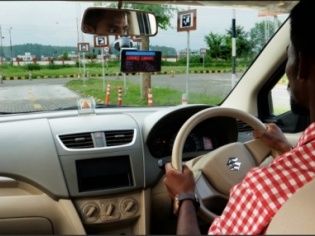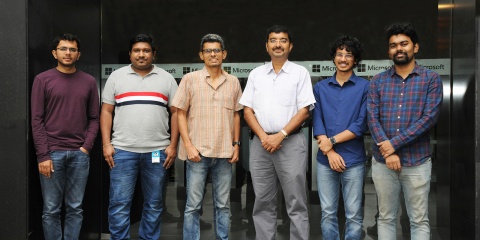-
Team TechTree
08:17 02nd Nov, 2019
Can Microsoft HAMs Make Indian Roads Safer? | TechTree.com
Can Microsoft HAMs Make Indian Roads Safer?
The AI-powered automated driving license test is currently being tested at the Regional Transport Office in Dehradun as part of a larger national-level experiment

Remember the jokes and memes when Google and Tesla’s auto-driving cars began testing? Most were a commentary on the haphazard nature of traffic on Indian roads and our callous driving habits. For, there’s has been only one all-pervading traffic rule in our country – see space, fill space!
Just when we thought that there’s no salvation from road accidents and loss of life, Microsoft has made a bold attempt to fix things. They have partnered with the government of Uttarakhand to trial HAMS (expanding to Harnessing Mobiles for Safety), an AI-powered technology that snugly fits into every smartphone to evaluate the capabilities of a driver during a license test.
As can be seen in this video, the application is capable of evaluating a driver’s skills at levels unheard of thus far at the state-level RTOs that conduct these tests before handing over a driving license. One is usually asked to make the figure ‘8’ to obtain a two-wheeler license or drive around a pre-defined path and reverse the vehicle into a slot to qualify as a licensed four-wheeler driver.
The HAMs Way
So, how does HAMS work? It uses the smartphone’s front and rear cameras and other sensors, to monitor the driver and the scenario in front viz., their gaze and the distance between other vehicles in front. It employs AI models developed by the Microsoft Research team to assess the several parameters about the driver’s skills, presence of mind etc.
For the driving test, HAMS has been customized to include capabilities such as precise tracking of the vehicle’s trajectory during designated test manoeuvres, for instance, parallel parking or negotiating a roundabout. This tracking enables HAMS to determine precisely, for instance, whether the driver stopped in the middle of a manoeuvre for longer than is permitted or tried to course correct by rolling forward and backward alternately more times than allowed, says the company in a statement.
The Big Challenge
The pressing challenge for driver testing in India is that close two two-thirds of those who apply actually do not take the test, according to a survey by SaveLIFE Foundation. Another challenge is that the burden is placed on human evaluators causing subjective opinions of a driver’s abilities. In other words, a lot depends on the cash that gets passed on under the table for a license.

“Automation using HAMS technology can not only help relieve evaluators of the burden but also make the process objective and transparent for candidates,” says Venkat Padmanabhan, Deputy Managing Director at Microsoft Research India, who began the project in 2016 after witnessing the chaotic traffic on Indian roads upon his return from the United States.
At the Dehradun RTO now, the driver just sits in a car that has the smartphone affixed to the windshield and goes around the test track. HAMS and the onsite server at the testing track do the rest to produce a detailed report shorting after the test that involves navigating through several pre-defined manoeuvres.
The Road Ahead
Given that the technology is easy to use and quite fool-proof, the challenge for the future would be as much in getting more transparency into the system through removing human intervention to the bare minimum. This would require an integration of the RTO systems with that of HAMS whereby a prospective driver can do all the paperwork online (which happens now) and continues to use the technology to get his test scores to a level where he can go and take the actual test on the track.
This way you remove the under-the-table component of the licensing process and ensure that every driver takes a test or several of them before they get to the optimal score that guarantees him the opportunity to get his license. Of course, there is the issue of standardising test tracks across the country, which may require massive investments given that no two RTOs function the same way.
Take the case of Bangalore where there are as many as five RTOs and each one has a test track that is radically different from the other. Which means that the assessor, often a policeman, gets to decide how the test is to be conducted and at best gets to spend 120 seconds watching the driver go through the track. As a result, the payments made to the local agent often plays the defining role!
The Bigger Challenge
Assuming that all the RTOs in India are equipped with HAMS from January 2020 (highly unlikely given the bureaucratic nature of the process), it still leaves the majority of the population with licenses that weren’t earned but bought. The question is would the government insist that every driver in the country uses the app to submit their test scores online to the RTO, which then reissues the license?
That would take some doing. Which means even though the new crop of drivers knows the rules, they would be driving amongst a crowd that doesn’t and couldn’t care less. So, to expect HAMS to cure India’s traffic problems over the near future could at best be a pipe dream.
A well-intentioned effort that can bear fruit only when every driver in India gets to use the app and assess his or her own driving skills. For that to happen, Microsoft would need to create an app that measures the change in our mindsets – our need to be safe on the road so that others feel safer.
Especially since the state governments seem to think that breaking road rules should not attract hefty fines. Why else would they water down an excellent central initiative to enhance road discipline through the Motor Vehicles Amendment Act passed by Parliament earlier this year?
- DRIFE Begins Operations in Namma Bengaluru
- Sevenaire launches ‘NEPTUNE’ – 24W Portable Speaker with RGB LED Lights
- Inbase launches ‘Urban Q1 Pro’ TWS Earbuds with Smart Touch control in India
- Airtel announces Rs 6000 cashback on purchase of smartphones from leading brands
- 78% of Indians are saving to spend during the festive season and 72% will splurge on gadgets & electronics
- 5 Tips For Buying A TV This Festive Season
- Facebook launches its largest creator education program in India
- 5 educational tech toys for young and aspiring engineers
- Mid-range smartphones emerge as customer favourites this festive season, reveals Amazon survey
- COLORFUL Launches Onebot M24A1 AIO PC for Professionals







TECHTREE